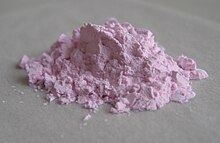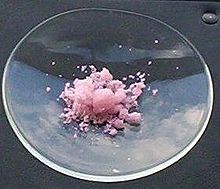Erbium compounds
Erbium compounds are compounds containing the element erbium (Er). These compounds are usually dominated by erbium in the +3 oxidation state, although the +2, +1 and 0[1] oxidation states have also been reported.
Oxides

Erbium(III) oxide (also known as erbia) is the only known oxide of erbium, first isolated by Carl Gustaf Mosander in 1843, and first obtained in pure form in 1905 by Georges Urbain and Charles James.[2] It has a cubic structure resembling the bixbyite motif. The Er3+ centers are octahedral.[3] The formation of erbium oxide is accomplished by burning erbium metal.[4] Erbium oxide is insoluble in water and soluble in mineral acids.
Halides

Erbium(III) bromide is a violet solid. It is used, like other metal bromide compounds, in water treatment, chemical analysis and for certain crystal growth applications.[14] Erbium(III) iodide[15] is a slightly pink compound that is insoluble in water. It can be prepared by directly reacting erbium with iodine.[16]
Borides
Other compounds

- Er(CH3COO)3·4H2O → Er(CH3COO)3 + 4 H2O
Continuing heating to 310 °C will form ketene:
- Er(CH3COO)3 → Er(OH)(CH3COO)2 + CH2=C=O
At 350 °C, the proposed Er(OH)(CH3COO)2 loses
Organoerbium compounds
Organoerbium compounds are very similar to
See also
- Holmium compounds
- Thulium compounds
- Ytterbium compounds
References
- .
- ISBN 978-0-486-64235-2.
- PMID 11848940.
- ISBN 978-0-19-850340-8.
- ^ "Erbium Fluoride".
- ISSN 2050-7526. Retrieved 2019-03-26.)
{{cite journal}}: CS1 maint: multiple names: authors list (link - ^ 苏伟涛, 李斌, 刘定权,等. 氟化铒薄膜晶体结构与红外光学性能的关系[J]. 物理学报, 2007, 56(5):2541-2546.
- PMID 35539388.)
{{cite journal}}: CS1 maint: multiple names: authors list (link - ^ Brauer, G., ed. (1963). Handbook of Preparative Inorganic Chemistry (2nd ed.). New York: Academic Press.
- ISBN 978-0-470-13256-2.
- ISBN 978-3-13-103021-4.
- .
- .
- ^ Elements, American. "Erbium Bromide". American Elements. Retrieved 2020-11-16.
- ^ ISBN 9781439814628. Retrieved 14 December 2013.
- ^ Elements, American. "Erbium Iodide". American Elements. Retrieved 2020-11-16.
- ^ American Elements
- ^ Samsonov, Grigorii (1965). High-Temperature Compounds of Rare Earth Metals with Nonmetals. New York: Consultants Bureau.
- ^ 《无机化学丛书》. 第七卷 钪 稀土元素. 易宪武 等主编. 科学出版社. P168~171. (2)氢氧化物
- ^ "Erbium Phosphide". American Elements. Retrieved 24 December 2021.
- Environmental Protection Agency. Retrieved 24 December 2021.
- ^ Toxic Substances Control Act (TSCA) Chemical Substance Inventory. Cumulative Supplement to the Initial Inventory: User Guide and Indices. United States Environmental Protection Agency. 1980. p. 129. Retrieved 24 December 2021.
- ^ "Referativnyĭ zhurnal: Khimii︠a︡" (in Russian). Izd-vo Akademii nauk SSSR. 1979: 468. Retrieved 24 December 2021.
{{cite journal}}: Cite journal requires|journal=(help) - materialsproject.org. Retrieved 24 December 2021.
- ISBN 978-1-83968-188-2. Retrieved 19 August 2021.
- ISBN 978-5-04-234580-7.
- ISBN 978-5-04-077039-7. Retrieved 19 August 2021.
- ^ Registry of Toxic Effects of Chemical Substances. National Institute for Occupational Safety and Health. 1987. p. 2186. Retrieved 19 August 2021.
- ISBN 978-0-412-30120-9. Retrieved 19 August 2021.
- .
- ISSN 0032-5910. Retrieved 2019-02-01.
- ^ Greenwood and Earnshaw, pp. 1248–9
